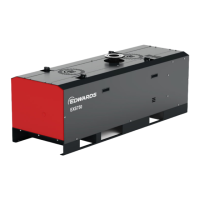CAUTION:
Use a ca
tchpot to prevent the drainage of condensate back into the dry pumping
system. Condensate that drains back into the dry pumping system could damage the
pump.
Do not reuse any O‑ring or O‑ring assembly and do not allow debris to get into the dry
pumping system during installaon.
When connecng the dry pumping system to the vacuum system, take note of the
following:
▪ To get the best pumping speed, ensure that the pipeline which connects the
vacuum system to the dry pumping system is the minimum length possible and has
an internal diameter not less than the system inlet port.
▪ Ensure that all components in the vacuum pipeline have a maximum pressure
rang which is greater than the highest pressure that can be generated in the dry
pumping system.
▪ Incorporate exible pipelines in the vacuum pipeline to reduce the transmission of
vibraon and to prevent the loading of coupling joints. We recommend using our
braided exible pipelines. The pipelines should be rated for 110 °C.
▪ Adequately support vacuum/exhaust pipelines to prevent the transmission of
stress to pipeline coupling joints.
▪ Incorporate a pressure gauge in the inlet pipeline to determine that the dry
pumping sy
stem operates correctly.
▪ The dry pumping system inlet must be able to be isolated from the atmosphere
and the vacuum system if pumping or producing corrosive chemicals.
▪ The outlet of the exhaust pipe can have a check valve ed which prevents the
suck‑back of exhaust vapours aer the dry pumping system is shut down. The
check valve also provides addional aenuaon of the pulses in exhaust pressure.
▪ For all the dry pumping systems, there is a limit to the length of NW50 pipeline
that can be used between the pump exhaust connecon and the facility exhaust.
For the dry pumping systems with a check valve, the length of the pipeline is
limited to 1 metre. For the dry pumping systems without a check valve, the length
is limited to 3 metres. If these lengths are exceeded, the pump will trip out due to
high exhaust pressure. If the distance to the facility exhaust is greater than these
limits, consider using an adaptor on the pump exhaust and a larger diameter
pipeline.
▪ For pumps running on dusty processes, we recommend that the exhaust line is
cleaned regularly as part of r
oune maintenance. Accumulaon of dust in the
exhaust line can reduce conductance and therefore increase exhaust pressure
which may damage the pump. The frequency of exhaust line cleaning depends on
the process. On very dusty applicaons, use a low-impedance inlet lter to reduce
maintenance requirements.
1. Referring to Figure: Connecng the pump inlet, r
emove the temporary cover or
blanking plate from the inlet of the dry pumping system. Take care not to drop
screws, tools and so forth into the pump inlet. Retain the nuts, bolts, washers and
blanking plate for future use. Retain the temporary cover for future use on
non‑contaminated pumps only. The inlet O‑ring is supplied with the pump, it is
ed underneath the inlet ange cover.
07/2021 - ©Edwards Limited
Page 36A41870880_A
A41870880_A - Inst
allaon

